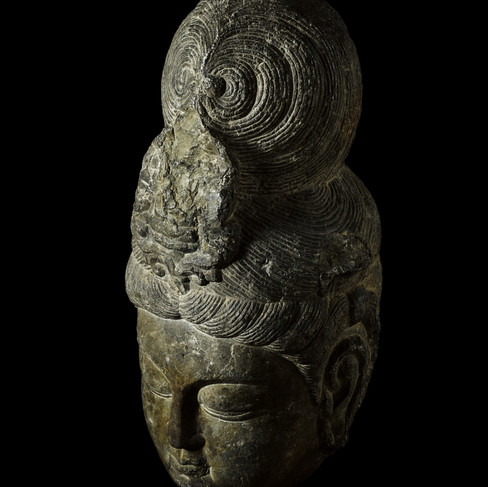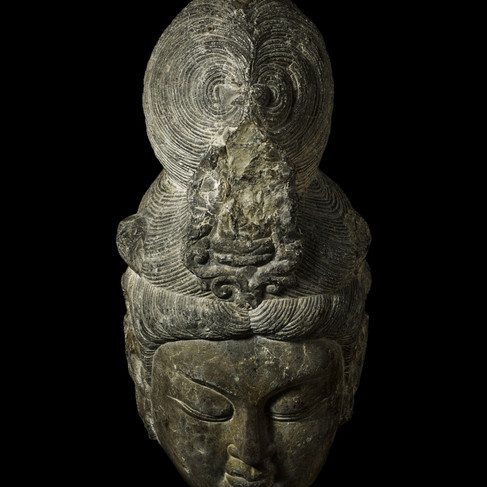拍賣筆記 vol.184 蘇富比香港:傳龍門石窟,唐代石灰石雕觀世音菩薩首像 - Longmen, A Very Rare Limestone Head Of Avalokiteshvara, Tang Dynasty
- SACA

- Apr 28
- 5 min read
Updated: May 7

近年來,龍門石窟、雲岡石窟、鞏縣石窟等造像在市場上十分流行。這件作品上拍前有市場質疑聲音,加上合法合規的擔憂,遺憾流拍。
參考蓮花洞被盜菩薩首的文章:
佛像筆記 vol.03 山中商會、喜龍仁:龍門石窟被盜北魏蓮花洞菩薩首 - Yamanaka, A Northern Wei Longmen Bodhisattva


唐 石灰石雕觀世音菩薩首像
PROPERTY FROM THE MQ COLLECTION | 莫勸齋珍藏
Session begins in
May 7, 11:45 AM JST
Estimate
1,800,000 - 4,000,000 HKD
Description
wood stand
47 cm

來源
Dikran G. Kelekian 收藏,編號2021
倫敦佳士得1998年6月15日,編號67
展覽
《歷代佛雕藝術之美》,歷史博物館,台北,2006年,編號33
《佛像:智慧與慈悲之身》,首爾大學博物館,首爾,2007年,編號30
出版
陳奕愷,〈歷史長河中的黃金時代——唐代造像藝術〉,《歷史博物館館刊:歷史文物》,台北,2006年,第十六卷,第十二期,頁48,圖版5
此尊菩薩首像雕工精湛,臉龐圓潤,鼻樑英挺,雙唇輕翕,眉宇舒展,兩眼微闔,面容殊美絕塵,氣度端嚴畢備。頭頂髮髻高聳,堆疊三層,自正中左右分梳,一絲不苟。髻前戴寶冠,龕阿彌陀佛小像於花莖上結跏趺坐,可辨此尊為觀世音。
觀世音與大勢至常伴阿彌陀佛之側,為脅侍菩薩,是慈悲化身,憐憫一切眾生,救拔苦難。觀世音久受奉持,其塑畫形像於唐代(618-907年)見顯著發展,原本常作男子形貌,氣宇如王者,至唐時,面容高貴,男女莫辨。唐代觀世音身量豐腴,多扭腰擺胯,彩衣華服,鬘雲簪寶,種種皆呈婀娜之態。
大乘經典《妙法蓮華經》廣宣流布,觀世音形像不辨男女或源於此。經中專有一品,稱揚觀世音神通之事,現比丘尼、童女、婦女等身,以種種形度脫眾生。敦煌莫高窟第45窟有一八世紀壁畫,為此品經變,描繪觀世音若干化現之形;各場景均見一人對另一者合十作禮,其中,另一者便是觀世音,化現之形有男有女、或神或人。
藝術表達不拘性別,加之時代風貌兼容並包,佛教藝術乃於盛唐走向巔峰。不論構思、工藝,此尊造像皆謂典範,原像體態及衣飾細節雖已不可考,僅憑首像髮式亦可窺見通身華貴。髮絲分作縷縷,沿髮際線往後梳束,此式早於隋代(581-618年)觀世音造像已有所見,如東京國立博物館藏一尊,大理石造,藏品編號TC-376。唐代造像將每縷髮絲加以雕琢,展現髮絲線條,突顯濃密。髮絲縷縷盤起,時而成辮,皆結成高髻,配戴珠寶,所戴多為頭冠,以花卉為形,安於髻前;亦有少數造像,兩鬢戴簪,束髮於耳上,恰如此尊。
比一石灰石雕菩薩全身像,先後為 Christian R. Holmes 夫人(1871-1941年)及史蒂芬•瓊肯三世(卒於1978年)舊藏,售於紐約蘇富比2018年9月12日,編號8,臉龐豐潤,髮髻高聳,垂髮成辮,披於肩後。再比石灰石雕菩薩首像兩尊,出自龍門石窟,現存龍門石窟研究院,編號31、33,皆高髻戴冠,梳束整潔。另比砂岩石雕菩薩首像一尊,原龕於天龍山石窟第21窟,現藏大都會藝術博物館,紐約,藏品編號42.25.12,高髻中分於此尊相類,頭冠同見花莖。天龍山石窟第14窟亦有一尊砂岩石雕菩薩像,鬢髮戴簪,錄喜龍仁,《Chinese Sculpture from the Fifth to the Fourteenth Century》,紐約,1925年,圖版495,然簪作花朵形,與此尊有別。

A very rare limestone head of Avalokiteshvara, Tang dynasty
Provenance
Collection of Dikran G. Kelekian (1867-1951), no. 2021.
Christie's London, 15th June 1998, lot 67.
Literature
Chen Yi-Kai, 'A Golden Age of Chinese History: The Art of Tang Statues', Bulletin of the Museum of History, vol. 16, no. 12, Taipei, 2006, p. 48, pl. 5.
Exhibited
The Beauty of Buddhist Sculptures, Museum of History, Taipei, 2006, cat. no. 33.
Buddha: The Embodiment of Wisdom and Compassion, Seoul National University Museum, Seoul, 2007, cat. no. 30.

Catalogue Note
The exquisitely sculpted head, once part of a life-size bodhisattva figure, embodies the artistic zenith of the Tang dynasty (618-907). Its fleshy face, marked by a straight nose, soft lips, and heavy-lidded eyes under arched brows, exudes timeless solemnity. Surmounting this transcendent visage is a three-tier chignon, meticulously combed and parted in the middle. A diadem enshrining a miniature of the Amitabha Buddha seated atop a foliate scroll stem accentuates the symmetry of the hairstyle and identifies the bodhisattva as Avalokiteshvara.
Often paired with Mahasthamaprapta flanking Amitabha in a triad, Avalokiteshvara is venerated as the incarnation of compassion and believed to extend infinite mercy on all sentient beings for their deliverance from suffering. Receiving continued popularity, Avalokiteshvara in the Tang dynasty saw an evident development in iconography, where the depiction of the bodhisattva shifted from a princely male in preceding times to a genderless noble person. Still of lean muscular build, Avalokiteshvara figures of the Tang period were portrayed with hips rhythmically swayed, bodies sumptuously attired, and hair finely bejewelled, all suggestive of feminine grace.
The gender fluidity of Avalokiteshvara in iconography likely emerged from the prevalent worship of the Lotus Sutra. This major Mahayana classic dedicates a whole chapter to praising Avalokiteshvara’s omnipotence that enables the bodhisattva to manifest in innumerable human or non-human forms, including nuns, girls, and wives. An 8th-century mural in Cave 45 of the Mogao Grottoes at Dunhuang illustrates this chapter and displays some forms Avalokiteshvara manifests to liberate those in need; in each of the scenes, a person makes a supplicatory gesture toward another figure, and the latter is Avalokitesvara, manifesting as either male or female, deity or human.
Unrestrained with gender conventions in the depictive language, also aided by the cultural climate of openness, Buddhist art reached a pinnacle during the High Tang, for which the present work in its conception and execution serves as an epitome. Though the flow of the body and the details of the garments are not visible, the hairstyle alone evokes the overall splendour. Hair coiffed strand by strand to frame the forehead had already appeared on stone figures of Avalokiteshvara in the Sui period (581-618); see one marble figure in the collection of the Tokyo National Museum, accession no. TC-376. The Tang artisans enhanced the strands with relief carving to bring out the combed texture, underscoring the luxuriance of hair. The elaborated hair strands are coiled up or plaited into a lofty topknot, and the hairstyle is adorned with a diadem of floral design in front of the chignon; in fewer instances, hairpins secure the hair above the ears on both sides, and the present work exemplifies such a style.
Compare an intact limestone figure of a bodhisattva for the fleshy face and the high chignon, first in the collection of Mrs Christian R. Holmes (1871-1941), later acquired by Stephen Junkunc III (d. 1978), sold in our New York rooms, 12 September 2018, lot 8; the hair is deftly plaited but cascades behind the shoulders. Compare another two limestone heads of bodhisattvas from the Longmen Grottoes, now conserved in the Longmen Grottoes Academy, nos. 31 and 33, both with combed hair knotted aloft and wearing diadems. Compare also a sandstone example, originally part of its shrine in Cave 21 of the Tianlongshan Grottoes, now in the Metropolitan Museum of Art, New York, accession no. 42.25.12; the topknot is middle-parted in like manner, and the diadem features a similar foliate stem. Concerning the detail of hair pinned above the ears, see another Tianlongshan sandstone figure from Cave 14, recorded in Osvald Sirén, Chinese Sculpture from the Fifth to the Fourteenth Century, New York, 1925, pl. 495; however, the hairpins take the form of flower blossoms.



















































Comments